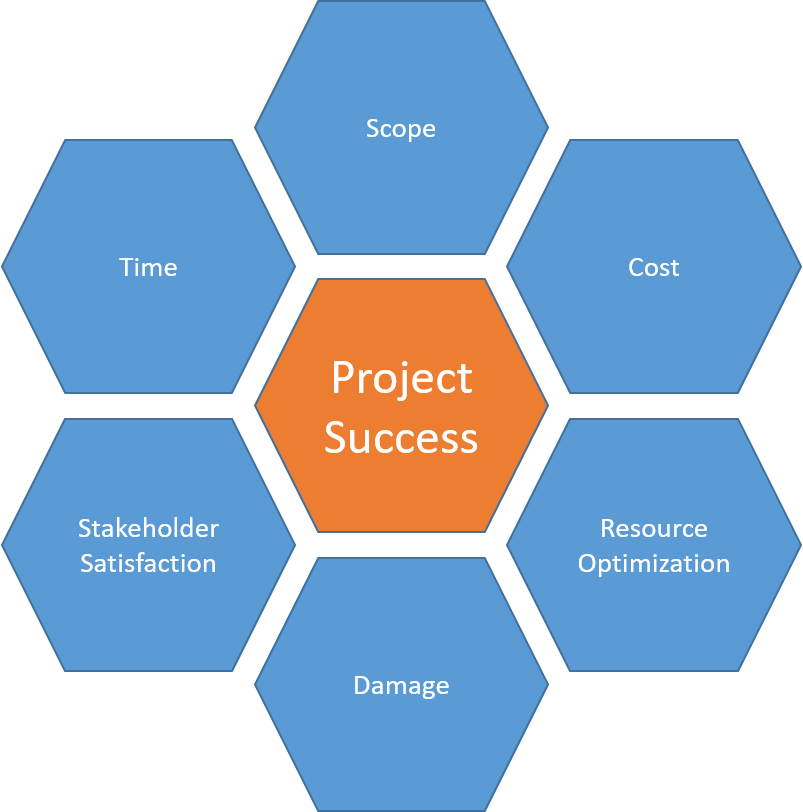Summary
The project objectives, the Magic Triangle, Triple Constraint or also called Objectives Triangle is a consolidated representation of the project objectives. In the course of time, a further target variable has been added to represent stakeholder satisfaction, especially client satisfaction. The project is carried out in the context of organisations. At least one organization provides resources in the form of project personnel and material resources. A simple resource planning of the project optimized for the project isolated from the context is not target-oriented. Further each project has not only positive aspects, but causes also a damage. These are the “six interdependencies” which also apply to agile project management approaches.
Origin and Development
The project objective variables, the magic triangle, triple constraint or also called objectives triangle is a consolidated representation of the project objectives on the basis of the measurement variables
- scope or service,
- cost (hours or person days and costs) and
- time (duration and dates).
In the course of time, a further target variable has been added, which is to represent stakeholder satisfaction, especially customer satisfaction. An extension to the magic square did not take place, but was seen as an extension of the magic triangle.
A magic square in connection with project management was mistakenly included in the literature, in which the quality was recorded separately. However, we must clearly distance ourselves from this, since quality is inherently anchored in the aforementioned goals.
We can therefore state that there are at least four indicators for the success of a project: scope, time, cost and stakeholder satisfaction.
Project success in the context of the environment
The project will be carried out in the context of organisations. At least one organisation provides resources in the form of project personnel and material resources. These are also limited and it is a component of the planning duties and thus criterion of the project success, how effectively the project personnel and how careful/limited the project resources are used for the entire organization. Because the project personnel is often entrusted with other tasks in the line and / or the coworkers are just as urgently looked for in other projects. The material resources such as an excavator become just as important for the course of the project on another construction site, for example. A simple resource planning of the project optimized for the project isolated from the context is not goal-prominent. The optimization needs which the project director, the project portfolio manager or the specialist departments specify for project resources are not only a one-sided process. Perhaps the consideration of this interdependence resource optimization in project success would also nip in the bud the thought construct of “thinking of project members only as inputs”.
Every project not only has positive aspects, but also causes damage. For example, an implementation of software may lead to job losses. Or an environmental protection project for the creation of a new nature reserve leads to the loss of a farmer’s arable land. This causes damage to the farmer, even if he is certainly compensated for it. So here we have a clear contribution to the project success in this case with a negative sign. We cannot simply deduct this negative contribution from the performance. Here we would make it too easy for ourselves, because the service is the desired dimension of the client and automatically does not take the damage into account.
In addition to scope, time, cost and stakeholder satisfaction, we have now established two further success criteria such as resource optimization and project damage.
We have thus outlined the “Six Interdependencies”.

Agility and the reflection of the Six Interdependencies
Now you might think the magic triangle was never relevant for me as an agile product owner anyway, because the performance is never relevant due to “fix” number of story points that can be processed in a sprint. This is deceptive and not really true, because by prioritizing the backlog the most important performance is of course defined as “part” of the project. Reprioritizing, adding or removing stories at the start of each sprint deliberately changes the performance of the project. So the six interdependencies are also likely to be relevant in agile practice.
